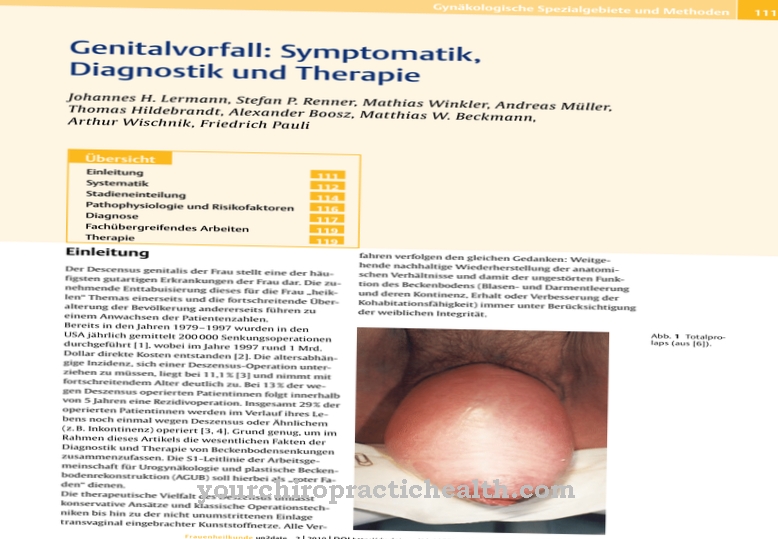A Umbilical cord wrapping (NSU) refers to the wrapping of the child's body by the umbilical cord. The looping can be single or multiple. Only in rare cases does it represent a dangerous complication.
What is umbilical cord wrapping?

© Erdem - stock.adobe.com
In about 30 percent of pregnancies there is one Umbilical cord wrapping of the fetus. It is a single or multiple wrapping of the umbilical cord around a part of the body such as the neck, arm, leg or trunk. Several parts of the body can also be affected at the same time. The umbilical cord wraps around the neck approximately 20 percent of the time. Boys are more often affected than girls.
The medical literature speaks of a birth complication, although a high percentage of umbilical cord involvement occurs during pregnancy. Only in very rare cases is it really a complication. It is even less likely to be the cause of death for the fetus. Usually the wrap is slack and therefore does not pose a threat to the oxygen supply to the fetus.
However, complications are sometimes observed during childbirth, as the wrap can become tighter here. A primary caesarean section is only necessary in exceptional cases when the umbilical cord is looped.
causes
The causes of umbilical cord wraps are diverse. The umbilical cord is often very long. In other cases, there is a strong increase in the amount of amniotic fluid (polyhydramnios). Observations have shown that boys are more frequently affected by NSU than girls. This fact is probably due to the greater mobility of male fetuses in the amniotic fluid. An increased amount of amniotic fluid increases the likelihood of NSU because the fetus has more freedom of movement in this case.
Polyhydramnios can in turn be triggered by several causes. Fetal causes are, for example, malformations of the digestive tract, spinal cord malformations, heart defects, absence of the cerebrum, fetal infections, genetic disorders of cartilage and bone formation, cleft lip and palate or chromosome aberrations.
Further causes of polyhydramnios on the maternal side can be incompatibility of the maternal and fetal blood group with formation of haemolysis in the fetus or diabetes mellitus. In diabetes mellitus, the amount of amniotic fluid is increased due to polyuria of the fetus. Polyhydramnios as a result of other disorders can cause the umbilical cord to become entangled, and in these cases the underlying disorder is usually the main risk for the fetus.
Symptoms, ailments & signs
Umbilical cord wrapping around the neck occurs in 20 percent of pregnancies. However, only in half of the cases there are noticeable changes in blood flow and heart rate. Most of the time, the drop in fetal heart rate (deceleration) is only temporary and has no major effects. If the NSU is tight around the neck for a long time, however, in exceptional cases intrauterine fetal death from fetal hypoxia fetal hypoxia (fetal oxygen deficiency) can occur.
However, due to the nature of the umbilical cord, oxygen starvation is rare. The fetus is supplied with oxygen-rich blood from the maternal bloodstream via the umbilical cord. This supply can only be disturbed by compression of the umbilical cord and the vessels in it. However, the umbilical cord is not so easy to compress due to its nature and structure.
Inside it is equipped with a compression-protecting connective tissue made of fine collagen fibrils, hyaluronic acid and proteoglycans, which is known as Wharton's jelly. In fetuses with a low percentage of Wharton's jelly, the risk of hypoxia in NSU is increased. Furthermore, the umbilical cord has left-twisted spirals, which also protect it from kinking and compression.
Diagnosis & course of disease
An umbilical cord can easily be detected prenatally with Doppler sonography. However, this examination is only recommended in the case of a previous miscarriage or stillbirth, where a connection with the NSU is suspected. During childbirth, an umbilical cord wrapping during the expulsion phase can lead to pathological changes in the fetal heart.
These changes can be detected with a cardiotocography. Here variable decelerations (lowering of the heart rate) are displayed, which usually only last a short time. A blood micrograph should then be performed to assess the child's oxygen supply.
Complications
An umbilical cord is itself a complication during pregnancy. However, it is rarely dangerous. Only in exceptional cases can serious complications occur, which in certain circumstances can even be fatal for the fetus. When the umbilical cord is looped, the arms, legs, torso or neck are wrapped by the umbilical cord. The blood supply to the brain in the fetus may be endangered, especially if the neck is tightly wrapped.
Then it comes to what is known as fetal hypoxia, which is characterized by an insufficient supply of oxygen to the child. As a result, intrauterine fetal death can occur. Although the umbilical cord is usually harmless and does not require any special measures, constant medical supervision should take place if an appropriate diagnosis is made.
This is the only way to ensure that rapid emergency medical help is possible in the event of a dangerous worsening of the situation. During the medical supervision of an umbilical cord loop, the oxygen content of the blood and regular heart rate measurements are used to examine the child's heart rate using micro-blood tests.
A very sharp drop in heart rate can indicate fatal danger to the fetus. Then action should be taken quickly. In individual cases, a primary caesarean section may be necessary. In this case, birth is induced by a caesarean section before labor begins. However, the necessary medical measures always depend on the condition of the fetus.
When should you go to the doctor?
Umbilical cord entanglement only affects fetuses in the womb and occurs in a large number of pregnant women. In most cases there is nothing to be concerned about. The wrapping is determined in imaging procedures at a gynecologist. An expectant mother should generally take part in all preventive and check-up examinations offered during pregnancy.
In these routine appointments, the development and health status of the growing child is documented and compared with the general guide values. If it is found that the umbilical cord is entangled, further observation is made until the end of the pregnancy, as there is a possibility of complications during delivery.
If a pregnant woman notices any sudden irregularities despite participating in all scheduled check-ups, she should consult a doctor immediately. If the fetus no longer moves, if there are changes in the heart rhythm or abnormal heart activity, a doctor must be consulted.
A vague feeling that something might be wrong with the fetus is enough for another visit to a doctor. Changes in blood flow, anxiety, or general malaise should be discussed with a doctor. If there is a sudden and therefore unplanned birth, the information about the umbilical cord loop should be passed on from the expectant mother to the obstetricians present.
Therapy & Treatment
The umbilical cord wrapping usually does not require any special measures. However, during the birth process, the heart rate of the child should be monitored via cardiotocography. If longer decelerations occur, it is also indicated to determine the oxygen supply by means of blood tests so that you can react quickly in an emergency. In individual cases, a primary caesarean section (caesarean section, caesarean section) may be necessary.
Particularly pregnant women who have had a previous stillbirth require special attention. However, it should be noted that the umbilical cord is usually not the primary cause of death of the child. As already mentioned, various previous injuries and illnesses of the child or mother can increase the likelihood of NSU, for example due to polyhydramnios. Often, however, the cause of stillbirth is to be found in this damage.
Outlook & forecast
The umbilical cord is not uncommon. According to statistical surveys, it appears at every fifth birth. It is often found during an ultrasound scan. However, the child in the womb is usually unaffected by the umbilical cord wrapping. Since it is very flexible, there are usually no complications. The birth goes smoothly. Overall, the forecast is therefore positive.
It should be noted that the umbilical cord does not have to be wrapped around the neck. Many medical laypeople wrongly fear that the child is strangling himself. In contrast, a loop can also be provided on an arm or leg. Such a situation significantly reduces the risk in the run-up to the birth.
While the prognosis is consistently positive, the treatment options are inadequate. Doctors are unable to change the embrace of the unborn child in the womb. It remains only to check the heartbeat regularly. Experience has shown that nature knows what to do best. If the child's condition worsens during pregnancy, a caesarean section may be indicated as a life-saving measure. In practice, however, this action is an exception.
prevention
It is not possible to prevent an umbilical cord wrapping in the growing fetus. NSU is a common side effect of childbirth and usually does not have a major impact on the child. Doppler sonography and cardiotocography should only be performed during pregnancy in risk cases.
There is a risk if a pregnancy has already resulted in a miscarriage or death in the past. Stricter monitoring is also recommended for certain maternal illnesses such as diabetes mellitus. In this case, however, the expectant mother can help reduce the risk of an umbilical cord by adopting a healthy lifestyle.
Aftercare
In most cases, the affected person has very few, and sometimes only limited, follow-up measures at their disposal. For this reason, those affected should consult a doctor at an early stage in order to prevent other symptoms or complications from occurring. As a rule, independent healing cannot occur, so that a doctor should be contacted as soon as the first signs and symptoms appear.
The umbilical cord wrapping is usually treated with a minor surgical intervention. There are no particular complications, and regular checks and examinations by a doctor are necessary even after the procedure. However, if the umbilical cord encircles the child before birth, no further treatment is possible.
Most of those affected are then dependent on psychological help, whereby especially loving and intensive discussions with their own family can have a very positive effect on the mental state of the parents. No further follow-up measures are available to the parents. The umbilical cord may also reduce the life expectancy of the child if it is recognized late.
You can do that yourself
An umbilical cord is often found by chance during ultrasound examinations during pregnancy. This shows how important it is for pregnant women to take advantage of all the examinations offered. This is the best way to ensure in everyday life that recognizable problems and health hazards for the unborn child are identified through the preventive benefits.
The mother herself cannot do anything if the umbilical cord is locked. There is no way to remove the umbilical cord from the baby's neck from the outside. That is why self-observation plays a major role in everyday life. Pregnant women whose child has been found to be wrapped around the umbilical cord in this way must recognize possible warning signs of imminent undersupply so that they can act quickly. If you notice, for example, decreasing child movements, you can neither diagnose nor treat this yourself.
The only way to get active yourself is to go to a gynecological practice or a hospital with obstetrics and have the child's care clarified via CTG. A known umbilical cord loop should not only be recorded in the maternity record. In unclear situations, the pregnant woman should always aggressively address this known danger again, because not all wraps that can cause problems for the child can always be recognized as such on the ultrasound.



.jpg)









.jpg)

.jpg)
.jpg)











.jpg)